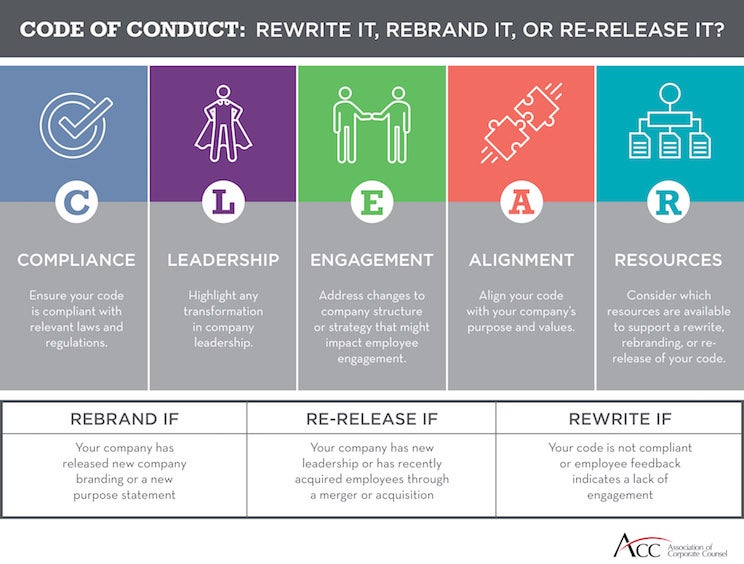
Your company's code of conduct can be an essential tool for ensuring a culture of integrity. Creating a guide that will help employees understand your company's values doesn't always require starting from scratch.
Rebranding or re-releasing your code can be just as impactful as a full rewrite. If producing an engaging and useful code of conduct is on your to-do list, here are five "CLEAR" steps you can take to determine the right approach.
Compliance: Ensure your code is compliant
Your code serves as your company's commitment to follow the law. It also signifies to your employees and stakeholders that ensuring compliance is important to your organization. While public companies are legally mandated to have a code of conduct, every company should have a single document that outlines key principles of compliance and ethical business conduct.
To ensure your code is compliant, first determine whether there have been relevant legal, regulatory, or policy changes that should be reflected in your code. Ideally, an internal working group or a more formally convened council with representation from key areas already supports this effort.
If not, arrange an external review of your code by an experienced law firm or compliance expert to make sure it meets all relevant mandates. This external review, which should occur at least every three years, not only adds credibility to your compliance process, but also provides a fresh look and can help identify potential issues you've previously overlooked.
Leadership: Highlight any transformation in company leadership
The most important element of a code of conduct is a strong, authentic statement of support from company leadership. While this statement is typically endorsed by a company's CEO or president, key leaders such as the general counsel, chief ethics and compliance officer, chief human resources officer, or board members can also impact how employees view leadership commitment to the code.
Your leader's statement should be reflective of his or her personality and vision for the company. If your company already has a code, consider whether the current statement truly speaks to the key characteristics that support your company's purpose and whether it incorporates elements of authenticity. And, it needs to be backed up by the actions of leaders.
Engagement: Address changes to company structure or strategy that might impact employee engagement
In business, as in life, change is the only constant. However, your code can be used to maintain engagement and demonstrate consistency in your company's view on business ethics and integrity.
If your organization has been involved in a merger, acquisition, or restructuring, your code may be due for an update to reflect a new employee base, expanded geographical region or additional product lines. Consider whether your code is translated into appropriate languages and whether it is written in a way that your full employee base can appreciate.
For example, if your company has a high retail or supply chain population, are the images and examples current and relevant to those employee groups? Do the colors and style reflect your company's overall image? Is your code "alive"? This means having videos, FAQs, and other engaging elements to encourage use.
Finally, what data or feedback is available to help determine whether employees are accessing your code outside of your annual training process? In short, are your employees proud of your code and do they feel a connection to it?
Alignment: Align your code with your company's purpose and values
The last several years have been met with a renewed flourish of organizations focusing on company purpose and values. That's because most successful companies know that taking deliberate steps to define their core purpose and values not only strengthens their bottom line, but also positively transforms other aspects of their business.
According to a 2016 Korn Ferry study, 90 percent of employees who worked in purpose-driven organizations reported feeling engaged at work versus 32 percent in other companies. Ensuring that your code is connected to your company's purpose and values helps eliminate confusion and contributes to a positive culture.
Ask the following: Are your company's purpose and values appropriately reflected in your code? Does the code contain relevant examples on how employees can demonstrate commitment to company values? Is your organization preparing to go through the process of developing its stated purpose and values in the near future?
Resources: Consider which resources are available to support a rewrite, rebranding, or re-release of your code
An equally important step in deciding the best approach to creating an impactful code is to consider the level of resources available. Beyond the potential fees associated with external services such as graphic design and language translations are the investment of time from internal resources.
Collaboration is key. It is also important to consider when your code was last reviewed, whether changes in laws or regulations require immediate updates, and whether the individuals who would be key contributors have the capacity to support the initiative. These factors can help determine the timing of any changes and the level of commitment required.
Your code serves as a central guide to help employees handle ethical dilemmas and demonstrate your company's commitment to integrity. Whether you rewrite, rebrand, or re-release your code, creating a dynamic resource for your company's employees can be simple if you follow the CLEAR path outlined above or in the infographic below.





